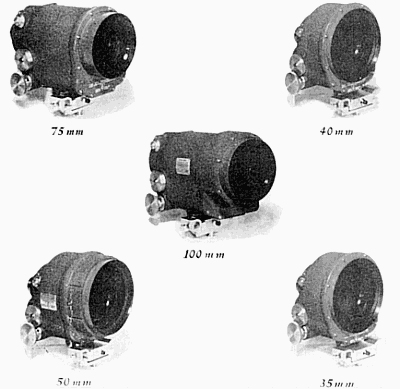![]() This permits a lens stop of f4 .5 which is sufficient to carry, quite
extreme ranges of focus. All wide screen methods using 35mm release
film require critical attention to the details which affect sharpness. This
is mostly a matter of film resolution, but anything we can do to maintain
maximum sharpness in the camera is on the credit side. Scenes of high
contrast usually appear sharper, when projected, than those of a flatter
nature and it is fortunate that modern colour films can be lighted with
relatively high contrast. With former colour films, we had to use a great
amount of fill light to prevent the shadow side of the faces from
reproducing with an objectionable reddish hue. Modern colour films
have the ability to preserve shadow detail without colour distortion, so
we may now use less fill light to obtain more interesting lightings and
also enhance picture definition. Night interiors now appear as they
should and, with the small amount of fill light needed, the lighting level
is not unreasonable for comfort nor in the amount of equipment used.
On large sets, the 10 k.w. lamp is the most practical unit, while on smaller
sets, 5 k.w.'s and 2 k.w.'s are the lamps used at the light levels suggested
above. Obviously, the f4 .5 stop is not inflexible. Many natural interiors
cannot be lighted at 1,000 foot candles and it is not necessary unless
there is a desire to carry depth of focus. With natural interiors, photo
flood lamps and -the smaller incandescent units are successfully used.
This permits a lens stop of f4 .5 which is sufficient to carry, quite
extreme ranges of focus. All wide screen methods using 35mm release
film require critical attention to the details which affect sharpness. This
is mostly a matter of film resolution, but anything we can do to maintain
maximum sharpness in the camera is on the credit side. Scenes of high
contrast usually appear sharper, when projected, than those of a flatter
nature and it is fortunate that modern colour films can be lighted with
relatively high contrast. With former colour films, we had to use a great
amount of fill light to prevent the shadow side of the faces from
reproducing with an objectionable reddish hue. Modern colour films
have the ability to preserve shadow detail without colour distortion, so
we may now use less fill light to obtain more interesting lightings and
also enhance picture definition. Night interiors now appear as they
should and, with the small amount of fill light needed, the lighting level
is not unreasonable for comfort nor in the amount of equipment used.
On large sets, the 10 k.w. lamp is the most practical unit, while on smaller
sets, 5 k.w.'s and 2 k.w.'s are the lamps used at the light levels suggested
above. Obviously, the f4 .5 stop is not inflexible. Many natural interiors
cannot be lighted at 1,000 foot candles and it is not necessary unless
there is a desire to carry depth of focus. With natural interiors, photo
flood lamps and -the smaller incandescent units are successfully used.
![]() The shape of the CinemaScope picture, as previously described,
was chosen because it approximates the angle of vision of the human
eye, therefore, the spectator becomes a participant of each scene. With
this fact in mind, it is good showmanship to devise as many camera
angles as possible for "audience participation." Low camera set-ups,
views taken straight ahead from moving vehicles, etc., all create
audience stimulation that lends excitement and enjoyment to the
production. They should be used whenever logically possible.
The shape of the CinemaScope picture, as previously described,
was chosen because it approximates the angle of vision of the human
eye, therefore, the spectator becomes a participant of each scene. With
this fact in mind, it is good showmanship to devise as many camera
angles as possible for "audience participation." Low camera set-ups,
views taken straight ahead from moving vehicles, etc., all create
audience stimulation that lends excitement and enjoyment to the
production. They should be used whenever logically possible.
![]() Rear projection scenes are easily accomplished and some, such as
automobile interior scenes, are enhanced in CinemaScope pictures.
Rear projection scenes are easily accomplished and some, such as
automobile interior scenes, are enhanced in CinemaScope pictures.

Fig. 5